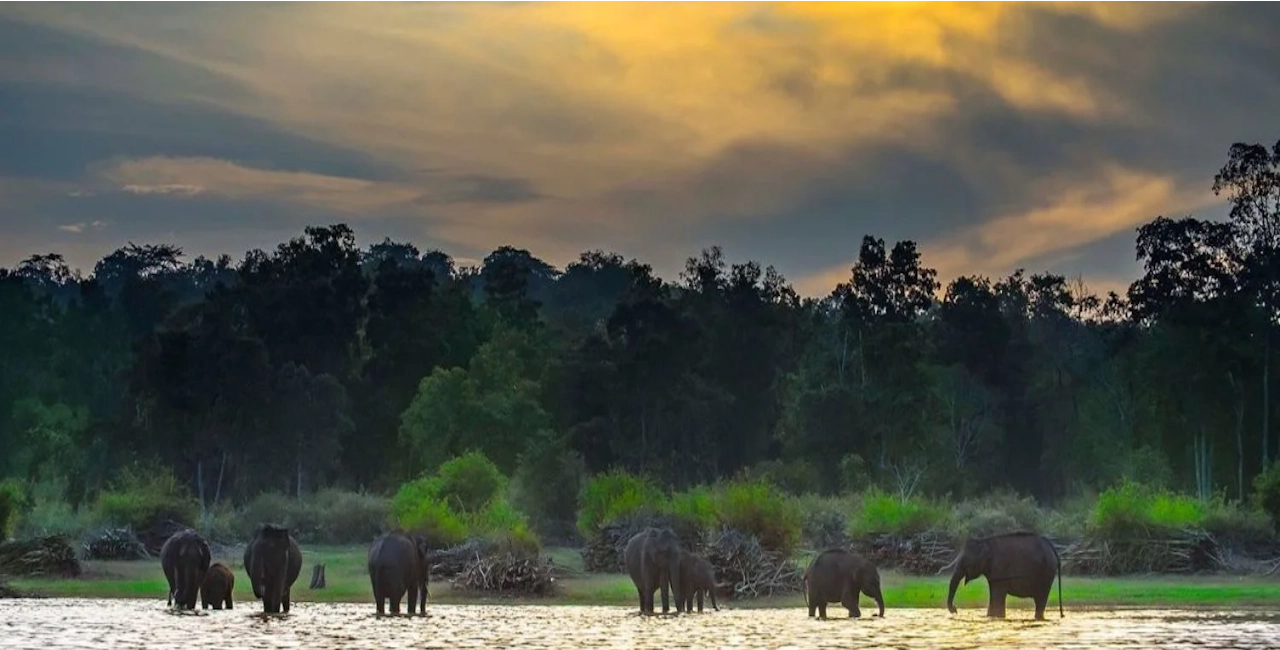Nestled in the lush landscapes of Karnataka, Nagarhole National Park is a paradise for nature enthusiasts and wildlife lovers. Officially known as Rajiv Gandhi National Park, this UNESCO World Heritage Site is part of the Nilgiri Biosphere Reserve and is one of India’s premier tiger reserves. With its dense forests, cascading waterfalls, and thriving biodiversity, Nagarhole National Park offers an unforgettable experience for visitors seeking to immerse themselves in the wonders of the natural world.
History and Significance
Nagarhole, which translates to “Serpent River” in Kannada, derives its name from the network of streams that snake through the park’s verdant terrain. Historically, the region served as a hunting ground for the Wodeyar kings of Mysore. Over time, it was transformed into a protected area to conserve its unique ecosystem and wildlife. Today, Nagarhole National Park plays a crucial role in India’s wildlife conservation efforts, particularly for the protection of tigers and elephants.
Geography and Climate
Spread across 848 square kilometers, Nagarhole National Park lies in the Kodagu and Mysore districts of Karnataka. The park’s diverse topography includes dense deciduous forests, swamps, streams, and open meadows, providing a variety of habitats for its flora and fauna. The Kabini River, which borders the southern part of the park, is a lifeline for the region and attracts a multitude of wildlife, especially during the dry season.
The park experiences a tropical climate, with temperatures ranging from 10°C to 35°C. The monsoon season (June to September) brings heavy rainfall, rejuvenating the forests and filling the rivers and streams, while the dry season (March to May) is ideal for wildlife spotting.
Flora and Fauna
Nagarhole National Park boasts an extraordinary range of biodiversity. The park’s vegetation primarily consists of moist deciduous and dry deciduous forests, interspersed with patches of teak and rosewood trees. Bamboo thickets and grasslands further enhance the ecological richness of the area.
Mammals
The park is renowned for its population of tigers and Asiatic elephants, which are among the main attractions for visitors. Other notable mammals include leopards, Indian wild dogs (dholes), sloth bears, gaurs, spotted deer, sambar deer, and wild boars. Nagarhole’s thriving wildlife makes it a key player in India’s Project Tiger initiative.
Birds
Birdwatchers flock to Nagarhole to observe its avian diversity. The park is home to over 250 bird species, including the Malabar pied hornbill, crested serpent eagle, and the white-bellied woodpecker. The vibrant birdlife adds to the park’s allure, making it a hotspot for ornithologists and photographers.
Reptiles and Amphibians
The park’s rivers and wetlands support a variety of reptiles, such as marsh crocodiles, monitor lizards, and Indian rock pythons. Amphibians like the Malabar tree toad and various species of frogs thrive in the park’s moist environment.
Activities and Attractions
Wildlife Safaris
The primary attraction at Nagarhole National Park is its thrilling wildlife safaris. Visitors can explore the park’s wilderness through jeep safaris and boat safaris. The safaris offer opportunities to spot tigers, elephants, and other wildlife in their natural habitat. Early morning and late afternoon are the best times for sightings.
Kabini Backwaters
The Kabini River and its backwaters are a highlight of Nagarhole, offering stunning views and unique wildlife experiences. During the dry season, the receding water levels create vast open spaces where herds of elephants and other animals gather, providing a spectacular sight for visitors.
Nature Walks and Birdwatching
For those who enjoy a slower pace, nature walks and birdwatching tours are excellent options. These guided experiences allow visitors to delve deeper into the park’s flora and fauna, with expert naturalists providing insights into the ecosystem.
Accommodation and Accessibility
A range of accommodation options is available near Nagarhole National Park, from luxury resorts to budget-friendly lodges. Many of these establishments offer packages that include safaris and other activities.
The park is well-connected by road and can be accessed from major cities like Mysore (96 kilometers) and Bangalore (236 kilometers). The nearest railway station is Mysore, and the closest airport is in Bangalore.
Best Time to Visit
The ideal time to visit Nagarhole National Park is between October and May, when the weather is pleasant, and wildlife sightings are at their peak. The dry season, in particular, is excellent for spotting animals near water sources.
Conservation Efforts
Nagarhole National Park is a critical component of the Nilgiri Biosphere Reserve and plays a vital role in preserving India’s biodiversity. The park’s conservation initiatives focus on protecting endangered species, mitigating human-wildlife conflict, and promoting eco-tourism.
Conclusion
Nagarhole National Park offers a perfect blend of adventure, tranquility, and natural beauty. Its pristine landscapes, diverse wildlife, and conservation significance make it a must-visit destination for anyone looking to experience the wonders of the wild. Whether you’re a wildlife enthusiast, a nature lover, or a casual traveler, Nagarhole promises an experience that is both enriching and unforgettable.


0 Comment